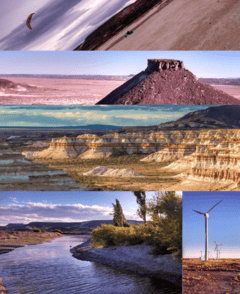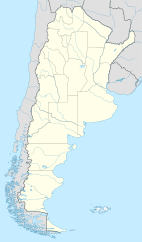Pico Truncado facts for kids
Quick facts for kids
Pico Truncado
|
|
|---|---|
|
Municipality and town
|
|
 |
|
| Country | |
| Province | |
| Department | Deseado Department |
| Established | 11 July 1921 |
| Area | |
| • Total | 30.3 km2 (11.7 sq mi) |
| • Land | 8 km2 (3 sq mi) |
| Population
(2010 census)
|
|
| • Total | 20,889 |
| • Density | 689/km2 (1,780/sq mi) |
| Demonym(s) | Truncadense |
| Time zone | UTC−3 (ART) |
Pico Truncado is a town and municipality in Santa Cruz Province, located in southern Argentina. In 1921, the town's railway station was part of a historical event called Patagonia rebelde. This event involved the Argentine Army and striking workers.
Contents
History of Pico Truncado
Ancient Inhabitants of the Region
The history of the Pico Truncado area goes back about 13,000 years. Stone tools found in local caves show that people lived here long ago. These early inhabitants arrived around 12,960 years ago. They left behind cave paintings and other signs of their culture. This area was once rich in water and plants. This attracted many different animal species.
Evidence shows that Mapuche and Tehuelche communities lived here 13,000 years ago. They hunted animals like guanaco and choiques. They also fished and gathered fruits. These groups faced strong winds and very cold winters. They created amazing art in various places. They traveled long distances to find good hunting grounds.
When Spanish conquerors arrived, these communities lost their freedom. Their lands became part of a new farming and livestock market. Later, during the Conquest of the Desert, they were forced to live in less favorable areas. Over time, the Tehuelche and Mapuche people blended their cultures.
The Patagonian Railroad's Impact
In 1908, President Figueroa Alcorta approved a law to build the Patagonian Railroad. This railway project was very ambitious. It aimed to cross the Argentine Patagonia. It would connect to another line going to Lake Nahuel Huapi. The project also wanted to help new towns grow in Patagonia. This was especially true for the Santa Cruz province.
Work on the railway began in May 1909 in Puerto Deseado. By late 1911, trains started running to Pico Truncado. This spot was known as "Km 200" because it was 200 kilometers from Puerto Deseado. The railway officially opened on December 31, 1913.
The railway helped many towns appear in northern Santa Cruz. In 1915, Pico Truncado became an important center. Many merchants, ranchers, and railway workers moved there. By 1917, public offices from Caleta Olivia moved to Pico Truncado. The town had about 200 people then. In 1918, the city's first official layout was planned.
Until the mid-20th century, Pico Truncado was a small town. It had fewer than 500 people. They lived by raising sheep and cattle. They sold their products using the railway. Pico Truncado officially became a town on July 11, 1921. This was by a decree signed by President Hipólito Yrigoyen.
The Patagonian Railroad branch closed on January 14, 1978. It was permanently shut down on January 1, 1979. Even so, this railway helped Pico Truncado grow. It also supported Puerto Deseado and other villages. These included Fitz Roy, Jaramillo, and Koluel Kayke.
Oil and Gas Discoveries
After 1946, the search for oil in northern Santa Cruz increased. Oil production began in 1950. This brought big changes to Pico Truncado. The state company YPF set up a large oil depot and housing. This led to the city's rapid growth.
Gas was discovered by accident near the city. Don Manuel Caamaño, a local resident, found it while digging a water well. In the 1960s, a State Gas Plant was built. This made the town known as "Pico Truncado, Capital del Gas" (Gas Capital).
The Pico Truncado-Buenos Aires Gas Pipeline opened on March 5, 1965. A fluid treatment plant also opened. These projects brought even more growth to the city.
New Technologies and Green Energy
Pico Truncado is known for its strong, constant winds. This makes it a great place for developing renewable energy. One important project is hydrogen energy.
The Hydrogen Experimental Plant is the only one of its kind in Latin America. It focuses on producing hydrogen fuel. It also researches and teaches about its uses. In 2004, the United Nations supported this project. The plant opened in 2005.
In 2007, Argentina's Congress passed a law to promote hydrogen. In 2014, Pico Truncado was declared the "National Hydrogen Capital." A major achievement was placing the first clean energy module at Esperanza Base in Antarctica. This module uses an electrolyzer, a wind turbine, a generator, and a kitchen that runs on hydrogen. This made Argentina the first country to use renewable energy in Antarctica.
The plant gets its electricity from the Jorge Romanutti Wind Farm. This wind farm opened in 1995. Wind energy uses the power of moving air. The park has four large wind turbines. They produce 2.4 megawatts of power. The average wind speed here is 10.3 meters per second. This makes it one of the windiest places in the country. This system needs little maintenance. It is also good for the environment because it produces clean energy.
Climate and Weather
Pico Truncado has a cold desert climate. Summers are warm, and winters are cold. It does not rain much here. The average rainfall is only about 162 millimeters per year.
| Climate data for Pico Truncado | |||||||||||||
|---|---|---|---|---|---|---|---|---|---|---|---|---|---|
| Month | Jan | Feb | Mar | Apr | May | Jun | Jul | Aug | Sep | Oct | Nov | Dec | Year |
| Daily mean °C (°F) | 17.1 (62.8) |
16.6 (61.9) |
14.3 (57.7) |
11.1 (52.0) |
7.2 (45.0) |
4.3 (39.7) |
4.1 (39.4) |
5.7 (42.3) |
8.2 (46.8) |
11.1 (52.0) |
14.1 (57.4) |
16.0 (60.8) |
10.8 (51.4) |
| Average precipitation mm (inches) | 10.8 (0.43) |
12.5 (0.49) |
15.9 (0.63) |
15.5 (0.61) |
20.1 (0.79) |
18.4 (0.72) |
17.9 (0.70) |
15.6 (0.61) |
8.1 (0.32) |
8.9 (0.35) |
9.0 (0.35) |
9.6 (0.38) |
161.9 (6.37) |
| Average precipitation days | 3.7 | 3.6 | 3.6 | 4.7 | 5.8 | 5.4 | 5.1 | 5.3 | 4.1 | 4.1 | 3.8 | 5.1 | 54.3 |
| Average relative humidity (%) | 42.6 | 44.2 | 48.2 | 53.4 | 62.2 | 65.8 | 64.8 | 59.6 | 53.1 | 47.1 | 42.8 | 41.2 | 52.1 |
| Percent possible sunshine | 49.7 | 53.6 | 48.8 | 45.5 | 42.8 | 41.3 | 42.4 | 45.7 | 47.1 | 49.9 | 50.3 | 48.3 | 47.1 |
| Source: Weatherbase | |||||||||||||
Sports and Activities
Basketball has been a very popular sport in Pico Truncado for over 30 years. A famous team was called La Garra Celeste. This team played in a national basketball tournament. Later, it became the Club Escuela de Básquet de Pico Truncado, also known as La Escuelita.
The city has two soccer teams, Defensores de Truncado and 13 de Diciembre. They play in the Santa Cruz North Soccer League. There is also a Neighborhood League where local teams compete.
Because of the strong winds, Pico Truncado is great for kitebuggy sports. This is where people ride a buggy pulled by a large kite.
See also
 In Spanish: Pico Truncado para niños
In Spanish: Pico Truncado para niños


